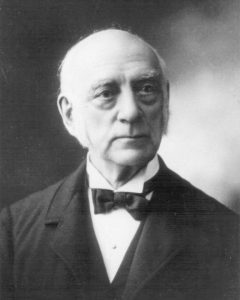
James Curtis Hepburn (1815-1911) was a medical missionary who is best known for his medical contributions to various communities in Japan as well as popularizing the Hepburn system of romanization of the Japanese language by publishing a successful Japanese-English dictionary.
After receiving his master’s and M.D. degrees from Princeton University and the University of Pennsylvania, respectively, Hepburn traveled to Asia as a medical missionary, staying in Singapore and China for five years total (1840-1845). In 1859 Hepburn returned to Asia as a medical missionary to Japan with the American Presbyterian Mission. Once arriving Hepburn moved to Kanagawa, the first missionary to do so. In 1862 he moved to Yokohama, which had only recently opened as a treaty port. Over the next several years, Hepburn lived in Yokohama and opened several free medical clinics and schools to serve the community, sometimes against the desires of the quickly disintegrating Shogunate government. He was well known for treating eye problems but also worked with internal medicine and surgery, famously performing surgery for gangrene on Japanese actor Sawamura Tanosuke. The Hepburn School, which he founded with his wife Clara, would later become Meiji Gakuin University. He was also appointed as the honorary physician to the US Consul, Townsend Harris.
Hepburn was also passionate about studying the language of Japan. During his time in China he spent time learning the Chinese language in order to explore his curiosity about Confucian thought, thinking that finding an intellectual middle ground between Confucian thought and Christianity would support his attempts to convert Japanese as a missionary. Over the first eight years of Hepburn’s stay in Japan, he worked with many Japanese assistants- notably Kishida Ginko- to build upon the translating work done by missionaries and Japanese alike before him, in order to eventually create the groundbreaking Japanese-English dictionary, published in 1867. A later edition of the dictionary published in 1886 used the Hepburn system, which structured the romanization of the Japanese language (Romajikai). While the system was created by the Society for the Romanization of the Japanese Alphabet, Hepburn is revered as the man who popularized its use. Throughout this time he also worked on translating the Old and New Testaments with Samuel Robbins Brown, Guido Herman Verbeck and Philip Kemball Fyson, which were both completed by 1887.
Works Cited:
Ion, Hamish, A. (2009). American Missionaries, Christian Oyatoi, and Japan, 1859-73. Vancouver, BC: UBC Press.
Michio, Takaya. “James Curtis Hepburn.” BDCC, Biographical Dictionary of Chinese Christianity, bdcconline.net/en/stories/hepburn-james-curtis.
“Virtual American Biographies.” James Curtis Hepburn, Edited Appletons Encyclopedia, 2001, famousamericans.net/jamescurtishepburn/.